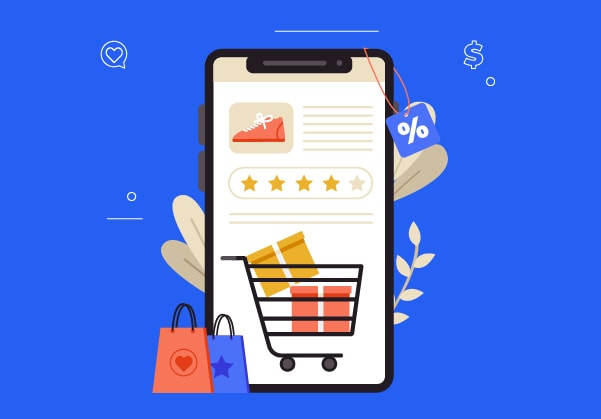
Content Marketing for Ecommerce – Top Tips to Drive Conversion
By: Nicole D’Angelo
11 minute read
It’s common knowledge that content marketing for ecommerce is important, but it can be tricky to identify everything that makes up a successful brand strategy. The ecommerce marketing landscape is constantly shifting, and what may have worked in the past might be less effective in 2023.
With these challenges facing marketers, it’s smart to start the year by taking stock of where your content marketing efforts currently stand and how they can be optimised for today’s content marketing landscape.
Whether you’re just getting started on your content marketing journey or have a long-running strategy you want to optimise, here are a few ideas to bring new life to your content marketing efforts.
KPIs for Ecommerce Cheat Sheet
Launch your ecommerce plans with this quick-hit cheat sheet that breaks down the top ecommerce KPIs for a successful year.
Establish Specific Ecommerce Content Marketing KPIs
The most crucial part of any content marketing strategy is having clear, specific goals that keep you on track.
In content marketing, a goal is typically defined as measurable key performance indicators (KPIs). You can determine your content marketing KPIs by deciding what you want your marketing efforts to accomplish and then attaching target numbers to those outcomes to make them measurable.
Some common KPIs used for content marketing for ecommerce include:
-
-
- Conversion rate
- Share of search
- Organic traffic
- Average time on site/page
- Audience engagement
- Social shares
-
As you evaluate your content marketing strategy, take some time to clarify or update your content marketing KPIs. This step will help you make sure the decisions you make about your strategy keep you on track to achieving what matters most to your brand.
Update Your Product SEO Strategy
Search engine optimization (SEO) is critical for successful content marketing, and today, a good SEO strategy requires more than just using the right keywords.
To rank in search and outperform competitors, you also need to make sure that your product content is well-written, that it answers shoppers’ questions, and that it includes helpful images and other forms of enhanced content.
You can take SEO optimisation one step further by thinking of creative keywords that go beyond bland descriptions of your product. Instead, consider what product qualities your shoppers are likely searching for and target secondary keywords related to those searches.
For example, a food and beverage brand could do keyword research on terms related to health and nutrition. A brand selling do-it-yourself (DIY) products could target secondary keyword phrases that contain terms like “beginner-friendly” or “easy to use.”
It’s also good practice to keep tabs on how search habits are changing and periodically update your SEO strategy accordingly.
For example, one current trend in ecommerce SEO is the rise of voice search. Ecommerce transactions done via voice are expected to garner $19.4 billion in 2023, according to Statista.
To win some of those sales, it’s a good idea to make sure your product pages are optimised for voice.
Facilitate the Creation of UGC
User-generated content (UGC) is one of the most cost-effective modes of content marketing — it costs little to produce and can be highly effective. There are two primary mediums for UGC: product reviews and social content.
Product reviews are an excellent way to boost sales. A survey from Digital.com found that 54% of shoppers read reviews for everything they purchase, and good reviews are often shoppers’ primary consideration when making online purchases.
You can grow your customer reviews by making the review process easy for satisfied shoppers to complete. When bad reviews come in, respond to them immediately so prospective consumers know you take their satisfaction seriously.
Responding immediately is also important when fielding complaints directed to your social accounts. But a winning social media strategy goes far beyond reacting to problems.
Engaging with your target audience about things they’re excited about can generate UGC that convinces your shoppers’ friends and followers to give your brand a try.
Today’s shoppers are savvier than ever about social advertising and rarely inclined to humour brand accounts, so you need to make an extra effort to be authentic, humorous, or relatable.
Updating your brand voice for a modern, sophisticated social audience may make shoppers more likely to engage in the type of organic interactions that result in new customers.
Modernise Your Approach to Personalisation
Personalisation in content marketing for ecommerce is far from a new trend, but approaches to it are evolving.
For one thing, consumers are now so accustomed to personalised content that they’re often more surprised when they don’t see it than when they do. McKinsey’s “Next in Personalisation 2021 Report” found that 76% of consumers get frustrated when they don’t find personalised content while shopping online.
At the same time, however, shoppers are becoming more wary of how companies use and abuse their data. KPMG’s “Corporate data responsibility: bridging the consumer trust gap” report shows that 40% of U.S. consumers don’t trust brands to use their data ethically.
The decline of third-party cookies around the globe puts further limits on the data brands can use for personalisation.
This shift in ecommerce data is forcing brands to instead leverage:
-
-
- First-party data: Data gathered from shopper activity on their website or product pages.
- Zero-party data: Data provided by the shopper via surveys, questionnaires, and other mediums.
-
Thirty-seven percent of brands rely exclusively on first-party data as of 2022, up from 31% in 2021, according to Twilio.
Whether your personalisation strategy is new or long-running, look for new approaches to personalisation that primarily use first- or zero-party data.
In addition to on-page product recommendations, consider leveraging this data to offer deals based on past purchases, send personalised emails inspired by user actions on your site, or share customised push notifications to users of your mobile app.
Invest in Video Content
Consumer preferences for video content have grown dramatically in recent years. Much of social media has become primarily video-based, thanks to the rapid rise of TikTok, and consumers are increasingly interested in learning about products via video.
Brightcove’s report “Using E-Commerce Video To Drive Sales: Why Consumers Rely on Video To Help Them Shop Online” found that 85% of global consumers think videos are essential for making online purchases.
If you haven’t invested in video content yet, now’s the time to start. Having videos on your product pages helps consumers feel more confident that they know what to expect from your product.
Additionally, video-based social content is a great way to reach a broader audience. After all, the second most popular social platform in the world is YouTube, according to Statista, and TikTok is so influential it occasionally tops Google as the most visited site on the internet, according to CBS.
Finding Success With Content Marketing for Ecommerce
The specific strategies that work for you will be unique to your brand and your shoppers. But these suggestions can get you started in the right direction for an approach to content marketing for ecommerce that succeeds.
Build a Winning Ecommerce Plan
Whatever shape your strategy takes, the key to success is to stay aligned with your long-term goals as defined by your KPIs. Download our ecommerce KPIs cheat sheet for advice on creating the KPIs that will keep your ecommerce efforts effective in 2023 and beyond.



